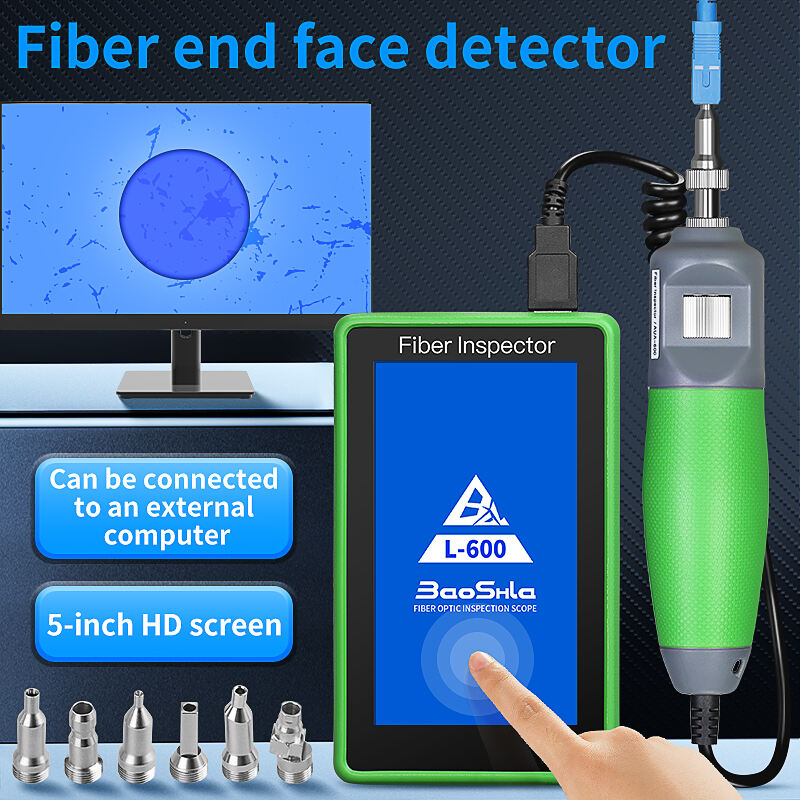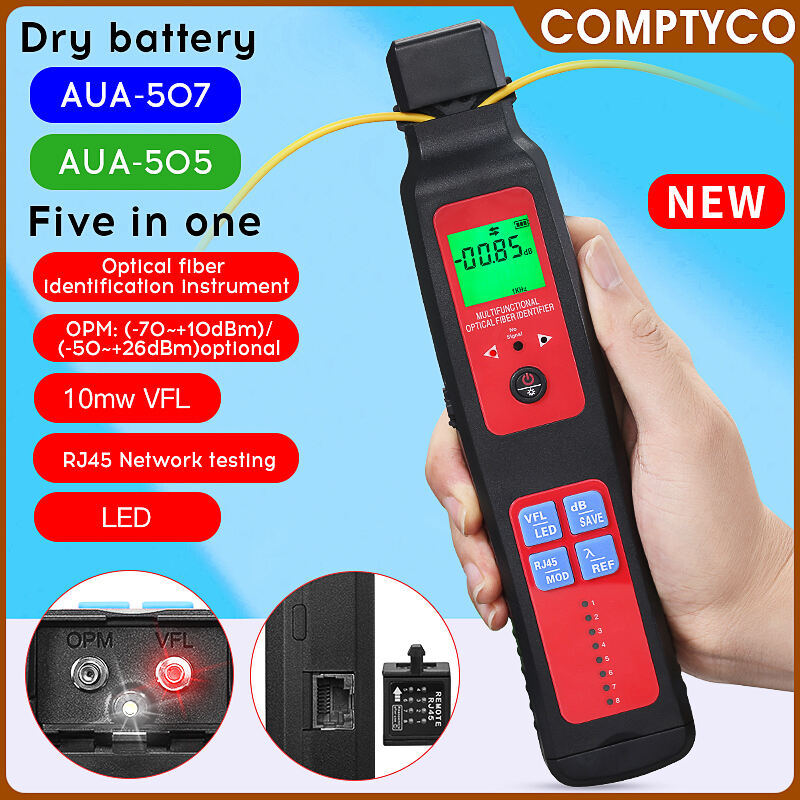Comprender el Papel Esencial de la Identificación de Fibra en las Redes Modernas
En el panorama actual de las telecomunicaciones, que evoluciona rápidamente, la capacidad de identificar y rastrear cables de fibra óptica se ha vuelto cada vez más crucial. Un identificador de fibra óptica sirve como una herramienta indispensable para técnicos e ingenieros de redes, permitiéndoles detectar fibras activas, determinar la dirección de la señal y garantizar un manejo adecuado del cable sin interrumpir las comunicaciones vitales. A medida que las redes crecen en complejidad y densidad, estos dispositivos sofisticados han pasado de ser accesorios convenientes a convertirse en equipos esenciales para cualquier persona que trabaje con infraestructura de fibra óptica.
La industria de las telecomunicaciones depende en gran medida de mantener una conectividad perfecta, y el uso adecuado de un identificador de fibra óptica puede marcar la diferencia entre un funcionamiento fluido de la red y costosas interrupciones del servicio. Estas herramientas especializadas han revolucionado la forma en que los técnicos realizan tareas de mantenimiento, solución de problemas e instalación de fibra, proporcionando un método no intrusivo para verificar señales ópticas y gestionar eficientemente los sistemas de cableado.
Tecnología principal y principios de funcionamiento
Mecanismo de detección y procesamiento de señales
El funcionamiento fundamental de un identificador de fibra óptica gira en torno a la tecnología avanzada de fotodetectores. Cuando se sujeta a un cable de fibra, el dispositivo induce una pequeña curvatura en la fibra, haciendo que una mínima parte de la luz escape. Esta luz fugada es capturada entonces por fotodetectores sensibles dentro del identificador, que analizan diversas características de la señal, incluyendo su presencia, dirección y niveles relativos de potencia.
Las unidades modernas de identificación de fibra óptica emplean algoritmos sofisticados de procesamiento de señales para diferenciar entre varios tipos de señales ópticas, incluyendo ondas continuas, señales moduladas e incluso patrones de tráfico. Esta capacidad garantiza lecturas precisas mientras minimiza los falsos positivos que podrían provocar errores operativos.
Metodología de pruebas no intrusiva
Uno de los aspectos más valiosos de un identificador de fibra óptica es su capacidad para realizar pruebas sin interrumpir ni romper el circuito óptico. El método de prueba por flexión induce una pérdida de señal mínima, típicamente inferior a 1 dB, lo cual es insuficiente para interrumpir el funcionamiento normal de la red. Este enfoque no intrusivo permite a los técnicos realizar mediciones e identificaciones necesarias manteniendo la integridad de la red y la continuidad del servicio.
La metodología de prueba también incorpora características de seguridad para proteger tanto al operador como a la infraestructura de red. Los identificadores modernos incluyen mecanismos automáticos de apagado y procedimientos adecuados de manejo para prevenir daños accidentales en circuitos ópticos de alta potencia.

Aplicaciones y Casos de Uso
Instalación y Mantenimiento de Redes
Durante nuevas instalaciones de red, un identificador de fibra óptica resulta invaluable para verificar el enrutamiento y las conexiones de cableado correctos. Los técnicos utilizan estos dispositivos para confirmar la presencia y dirección de la señal antes de realizar conexiones o empalmes permanentes, evitando posibles configuraciones incorrectas que podrían provocar problemas en la red. La capacidad de identificar rápidamente las fibras activas ayuda a agilizar el proceso de instalación y reduce la probabilidad de errores.
En escenarios de mantenimiento, estas herramientas permiten a los técnicos localizar y aislar de forma segura fibras específicas dentro de haces de cables sin riesgo de interrupción del servicio. Esta capacidad es particularmente crucial en centros de telecomunicaciones densos donde pueden estar presentes cientos o miles de fibras en estrecha proximidad.
Operaciones de diagnóstico y reparación
Cuando surgen problemas en la red, un identificador de fibra óptica se convierte en una herramienta de diagnóstico esencial. Los técnicos pueden rastrear rápidamente las trayectorias de la señal, identificar interrupciones o degradaciones en el circuito óptico y localizar las áreas que requieren atención. La capacidad de determinar la dirección de la señal y los niveles relativos de potencia ayuda a aislar fallos y guiar eficientemente las labores de reparación.
Durante reparaciones de emergencia o modificaciones en la red, estos dispositivos ayudan a garantizar que los técnicos trabajen en las fibras correctas, evitando interrupciones accidentales del servicio en circuitos activos. Esto es particularmente importante en entornos críticos donde la inactividad de la red puede tener consecuencias graves.
Mejores prácticas para un rendimiento óptimo
Requisitos de calibración y mantenimiento
Para asegurar lecturas precisas, es fundamental realizar una calibración periódica del equipo identificador de fibra óptica. La mayoría de los fabricantes recomiendan controles anuales de calibración, aunque los requisitos específicos pueden variar según los patrones de uso y las condiciones ambientales. El mantenimiento adecuado incluye la limpieza regular del área de detección, la inspección de los mecanismos de sujeción y la verificación de los sistemas de batería en unidades portátiles.
Los factores ambientales, como la temperatura, la humedad y la exposición a contaminantes, pueden afectar el rendimiento del dispositivo. Mantener condiciones adecuadas de almacenamiento y seguir los parámetros operativos especificados por el fabricante ayuda a preservar la precisión y prolongar la vida útil del equipo.
Pautas Operativas y Protocolos de Seguridad
Los procedimientos correctos de manipulación son cruciales tanto para mediciones precisas como para la seguridad del operador. Los técnicos siempre deben verificar que el rango de potencia del identificador coincida con las especificaciones de la red antes de su uso. Una preparación adecuada de la fibra, incluyendo la limpieza y una colocación cuidadosa en el área de detección del dispositivo, asegura lecturas confiables y previene daños tanto en la fibra como en el identificador.
Los protocolos de seguridad deben cumplirse estrictamente, especialmente al trabajar con sistemas ópticos de alta potencia. Siempre se debe utilizar equipo de protección personal, incluyendo protección ocular adecuada, en conjunto con el identificador de fibra óptica. Además, los técnicos deben seguir los procedimientos adecuados para manipular fragmentos de fibra y mantener un entorno de trabajo limpio.
Tendencias futuras y avances tecnológicos
Capacidades Mejoradas de Detección
La próxima generación de tecnología de identificación de fibra óptica está avanzando rápidamente, con mejoras en sensibilidad, precisión y capacidades de análisis de señales. Se están desarrollando nuevos modelos con mayor capacidad para distinguir entre diferentes tipos de señales ópticas, incluyendo protocolos de transmisión de alta velocidad emergentes y sistemas de comunicación cuántica.
La integración de algoritmos de inteligencia artificial y aprendizaje automático está permitiendo un análisis de señales más sofisticado y capacidades de detección automática de fallos. Estos avances facilitan que los técnicos identifiquen y diagnostiquen problemas complejos de la red de forma rápida y precisa.
Integración con sistemas de gestión de red
Las unidades modernas de identificación de fibra óptica están siendo diseñadas cada vez más con interfaces digitales que permiten la integración con sistemas más amplios de gestión de red. Esta conectividad posibilita el registro de datos en tiempo real, capacidades de monitoreo remoto y la documentación automatizada de los resultados de pruebas. Dicha integración optimiza los procesos de trabajo y proporciona una mejor supervisión de las actividades de mantenimiento de la red.
La tendencia hacia herramientas conectadas también está facilitando capacidades de mantenimiento predictivo, donde los datos de pruebas pueden analizarse para identificar posibles problemas antes de que causen fallos en la red. Este enfoque proactivo del mantenimiento de redes se está volviendo cada vez más importante a medida que las redes crecen en complejidad y dependencia de infraestructuras de fibra óptica confiables.
Preguntas Frecuentes
¿Qué tipos de señal puede detectar un identificador de fibra óptica?
Un identificador de fibra óptica moderno puede detectar varios tipos de señal, incluyendo onda continua, señales moduladas de 270 Hz a 2 kHz y patrones de tráfico de alta frecuencia. Los modelos avanzados también pueden distinguir entre diferentes protocolos de transmisión y proporcionar mediciones relativas de nivel de potencia para un análisis de señal completo.
¿Con qué frecuencia debe calibrarse un identificador de fibra óptica?
La mayoría de los fabricantes recomiendan la calibración anual del equipo identificador de fibra óptica para mantener una precisión óptima. Sin embargo, los dispositivos utilizados en entornos adversos o que se operan con frecuencia pueden requerir calibraciones más frecuentes. Consulte siempre las pautas específicas del fabricante para obtener programas detallados de mantenimiento.
¿Puede un identificador de fibra óptica dañar circuitos activos?
Cuando se utiliza correctamente, un identificador de fibra óptica provoca una pérdida mínima de señal (típicamente inferior a 1 dB) y no dañará los circuitos activos. Sin embargo, es fundamental seguir las pautas del fabricante respecto a los niveles de potencia y los procedimientos adecuados de manipulación para prevenir cualquier daño potencial a la infraestructura de red de fibra óptica.







